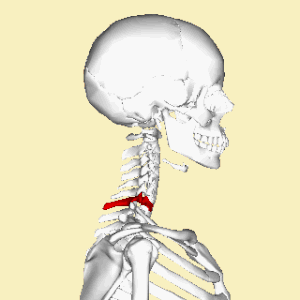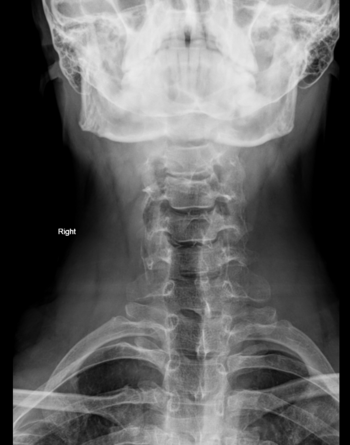Clay-shoveler fracture
| Clay-shoveler fracture | |
|---|---|
 | |
| C7 spinous process. | |
| Specialty | Neurosurgery |
Clay-shoveler's fracture is a stable fracture through the spinous process of a vertebra occurring at any of the lower cervical or upper thoracic vertebrae, classically at C6 or C7.[1] In Australia in the 1930s, men digging deep ditches tossed clay 10 to 15 feet above their heads using long handled shovels.[2] Instead of separating, the sticky clay would sometimes stick to the shovel. At the top of the arc of motion, with the arms extended, the worker may hear a pop and feel a sudden pain between the shoulder blades, unable to continue working.[3][4] The mechanism of injury is believed to be secondary to muscle pull and reflex with force transmission through the supraspinous ligaments. The tremendous force pulls on the spinous process producing an avulsion fracture. The fracture is diagnosed by plain film examination.[citation needed]

References
- ↑ Brant W, Helms C. "Fundamentals of Diagnostic Radiology" (Third Edition): 1110.
{{cite journal}}: Cite journal requires|journal=(help) - ↑ McKellar Hall RD (1940). "Clay-Shoveler's Fracture". J Bone Joint Surg Am. 22: 36–75.
- ↑ Shiel Jr., MD, FACP, FACR, William C. "What Is a Clay-Shoveler's Fracture?". MedicineNet. Archived from the original on 24 June 2021. Retrieved 17 June 2021.
{{cite web}}: CS1 maint: multiple names: authors list (link) - ↑ Posthuma de Boer, Jantine; van Wulfften Palthe, Alexander F. Y.; Stadhouder, Agnita; Bloemers, Frank W. (September 2016). "The Clay Shoveler's Fracture: A Case Report and Review of the Literature". The Journal of Emergency Medicine. 51 (3): 292–297. doi:10.1016/j.jemermed.2016.03.020. ISSN 0736-4679. Archived from the original on 24 June 2021. Retrieved 17 June 2021.